

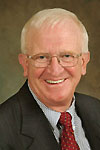 I am now well into my second decade of service to UW-Stout, and I remain extremely impressed with the positive, proactive attitude that has always characterized the campus. Faculty, staff and students remain excited about the future of this fine university, even with rather dramatic reductions in our budget. People take pride in our unique special mission; the friendly, collegial environment; and the commitment we have to students and to quality education.
I am now well into my second decade of service to UW-Stout, and I remain extremely impressed with the positive, proactive attitude that has always characterized the campus. Faculty, staff and students remain excited about the future of this fine university, even with rather dramatic reductions in our budget. People take pride in our unique special mission; the friendly, collegial environment; and the commitment we have to students and to quality education.
The key to any successful organization is planning, and we continue a very dynamic planning process, focusing on the future of UW-Stout. In 2003, we chose the theme of Focus 2010, asking how we should position this institution for the 21st century. In the fall of 2003, we engaged the faculty, staff and students in this discussion, and more than 300 participated. Further, campus discussion in the winter and spring of 2004 identified five broad goals; and, during our annual summer retreat, we identified priorities for the institution within those goals. They include: develop an efficient enrollment management plan; serve the students from the technical college system more effectively; revise our academic programs to ensure they are relevant; identify new programs and deploy them quickly; develop more science, technology and engineering options; develop learning communities; integrate the e-Scholar program into the learning communities; promote the Stout Technology Advantage; establish processes for evaluating emerging technologies; and continue to explore a “for profit” arm for UW-Stout. Teams are presently working on final plans and an implementation process for these goals.
During 2003-04, the university was aggressive in seeking extramural funding, with a great deal of success. A Title III grant from the U.S. Department of Education, in the amount of $1.75 million, was awarded to UW-Stout to integrate advisement, mobile technologies and program assessment. In partnership with UW-River Falls and CESA 11, we share a grant of $750,000 from the Department of Education to promote more effective teaching of history in the K-12 system. The National Science Foundation awarded two of our mathematics professors $261,000 to study Visualization Software. Our technology education program, through a unique partnership with six other universities, is part of a $10 million grant to strengthen engineering education in K-12; our share is $750,000. The U.S. Department of Education awarded the university $200,000 to study a Campus Violence Prevention project. These are good examples of how active our faculty and staff are, and it reflects on the strong sense of professionalism we have on campus.
We continue to develop and implement new academic programs as well, since this is the heart of a university. A new master’s degree in manufacturing engineering, and new undergraduate programs in special education and golf enterprise management are welcome additions to our growing array of programs that reflect the special mission of this university.
I hope this gives a flavor of a dynamic, forward looking university; one that will provide the kind of educational programs needed for this century. This is UW-Stout, and we are very proud of this excellent institution.
Charles W. Sorensen
Chancellor
Higher education is undergoing dramatic change. State support and funding continues to shift toward health care, corrections, shared revenues and other state priorities. With that in mind, UW-Stout developed a long-range planning process called Focus 2010 in 2003. Focus 2010 is a plan meant to look forward to the year 2010, identifying the important initiatives the university must undertake to remain a viable institution within its special mission.
Focus group sessions began in the fall of 2003 and were used to identify campus priorities that would reflect upon the future of higher education at UW-Stout. The sessions served as a way to look past current budget issues and daily operational issues, and imagine the structure, program array, enrollment, and approach to instruction for the future.
The Chancellor's Advisory Council used scenario planning to envision UW-Stout in 2010. Discussion began by identifying driving forces of change, major strengths of the campus and future opportunities. From this, the group projected a Background for Higher Education, Student Characteristics and Expectations, Faculty/Staff Characteristics and Expectations, and Institutional Characteristics.
From this review and discussions with a senior scholar from the Project on the Future of Higher Education, the Chancellor's Advisory Council identified four major themes. Five specific long-term goals were identified within these themes. The goals were discussed thoroughly at campus forum sessions throughout 2003–04. The themes and goals include:
During the summer of 2004, a broadly represented group of faculty, staff, students and administrators used the goal documents to identify university priorities for 2004–06 and implementation plans for 2004–05. These were to be reviewed with the entire campus during the fall of 2004.
Implementation plans for the 2004–05 academic year include:
 UW-Stout and Wisconsin's technical colleges have begun a cooperative program designed to keep educated workers in the state.
UW-Stout and Wisconsin's technical colleges have begun a cooperative program designed to keep educated workers in the state.
The program allows a seamless transfer of credits from technical schools to UW-Stout. After completing a technical degree in certain areas, students could continue on to get their bachelor's degree. UW-Stout will use distance education and online classes so students will be able to stay in their home areas and finish their degrees.
The effort will help reverse a trend that has seen many of Wisconsin's educated workers head to other states for better paying jobs. Recently, some students who graduated from technical colleges in Wisconsin moved to Illinois and Minnesota because the credits transfer more easily to the colleges in those states, taking educated students out of Wisconsin in the process.
There are 20 to 30 schools across the country with a similar program, but UW-Stout is the first to feature such a program in Wisconsin.
Some of the majors that fit easily include graphic communications management, business, engineering technology, construction, telecommunications and hospitality.
(Goal 1, Figure 1)
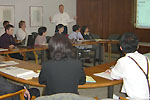 As the first university to receive the Malcolm Baldrige National Quality Award, UW-Stout has taken a national leadership role in higher education through its Center for Assessment and Continuous Improvement. This center manages requests from a variety of organizations that want to learn more about the benefits of the Baldrige model. The center's quality consultants provide these organizations with the knowledge, skills and tools essential for designing and implementing a continuous improvement program.
As the first university to receive the Malcolm Baldrige National Quality Award, UW-Stout has taken a national leadership role in higher education through its Center for Assessment and Continuous Improvement. This center manages requests from a variety of organizations that want to learn more about the benefits of the Baldrige model. The center's quality consultants provide these organizations with the knowledge, skills and tools essential for designing and implementing a continuous improvement program.
The 2003–04 academic year was the first for UW–Stout's School of Education, providing a vital link between theory and practice in the educational arena.
The School of Education was formed in 2003 to serve as a common voice for professional education and to give increasing emphasis on the significance of professional education programs at UW-Stout.
Faculty and staff in the school bring diverse talents, perspectives and expertise to the field of education. Their specific mission is to provide leadership, scholarship and service in undergraduate and graduate programs that lead to professional education careers.
A rich array of graduate and undergraduate programs that have achieved state, national and international prominence is provided in the School of Education. These programs speak to the needs of our global society and allow students the opportunity to work in a wide variety of educational settings. The School of Education is shaped by the history and rich traditions of the programs in it.
Some of the highlights of the school's first year include:
UW-Stout's School of Education offered a new online summer professional development program for K-12 educators during the summer of 2004.
Through 30 new completely online classes, elementary, middle school and high school teachers were able to earn credits for license renewal via the World Wide Web. UW-Stout's goal is to serve as an outreach center to meet the growing demand for advanced teacher education. This effort supports recertification requirements and professional growth plans.
The courses offered were designed to help build bridges between where educators are now and where they need to be to meet the needs of their students, and were aligned with Wisconsin Standards for Teaching and National Educational Technology Standards for Teachers.
 UW-Stout's apparel design and development program received an endorsement from the American Apparel and Footwear Association's Professional Leadership Council. The endorsement, which lasts through January 2008, includes both the pre-production and the operations course tracks of the program.
UW-Stout's apparel design and development program received an endorsement from the American Apparel and Footwear Association's Professional Leadership Council. The endorsement, which lasts through January 2008, includes both the pre-production and the operations course tracks of the program.
Review and endorsement of the apparel program by the AAFA ensures that UW-Stout graduates have the competencies that are needed by business and industry. AAFA endorsement also allows students in the program to apply for scholarships from the association.
 Three UW-Stout academic programs were awarded accreditation from the National Association of Industrial Technology. UW-Stout's packaging, graphic communications management, and telecommunication systems programs met NAIT's rigorous standards to achieve accreditation through November 2009. The three NAIT-accredited programs involve their students in current industry projects and hands-on laboratory activities that reflect the current needs and future trends in industry. For example, packaging students have designed golf ball packages for Acculine, hearing aid battery packaging for Rayovac, and Crayola marker containers for Binney and Smith.
Three UW-Stout academic programs were awarded accreditation from the National Association of Industrial Technology. UW-Stout's packaging, graphic communications management, and telecommunication systems programs met NAIT's rigorous standards to achieve accreditation through November 2009. The three NAIT-accredited programs involve their students in current industry projects and hands-on laboratory activities that reflect the current needs and future trends in industry. For example, packaging students have designed golf ball packages for Acculine, hearing aid battery packaging for Rayovac, and Crayola marker containers for Binney and Smith.
 The UW-Stout school psychology graduate program received full approval from the National Association of School Psychologists. Fewer than two-thirds of the school psychology graduate programs in the nation are NASP approved. NASP approval indicates that UW-Stout's program provides graduate students with quality training and extensive field experiences in school psychology. The approval also ensures that graduates of the program are automatically eligible for National Certification in School Psychology. To complete the certification process, they must conduct an approved internship and pass the National School Psychology Examination.
The UW-Stout school psychology graduate program received full approval from the National Association of School Psychologists. Fewer than two-thirds of the school psychology graduate programs in the nation are NASP approved. NASP approval indicates that UW-Stout's program provides graduate students with quality training and extensive field experiences in school psychology. The approval also ensures that graduates of the program are automatically eligible for National Certification in School Psychology. To complete the certification process, they must conduct an approved internship and pass the National School Psychology Examination.
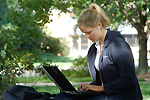 UW-Stout was the first public university in Wisconsin to introduce students to a wireless laptop campus, and is in the company of 100 laptop universities nationwide. Still, Stout's e-Scholar program stands out even from these few by attempting to measure what the others are not -- how laptops add value to students' total experiences.
UW-Stout was the first public university in Wisconsin to introduce students to a wireless laptop campus, and is in the company of 100 laptop universities nationwide. Still, Stout's e-Scholar program stands out even from these few by attempting to measure what the others are not -- how laptops add value to students' total experiences.
During the past two years, surveys, focus groups and database studies that were conducted using standard, reputable methods provided key findings for the e-Scholar program:
Students in the e-Scholar program report high ratings on survey questions dealing with computer and Internet usage, the computer saving time, and computer use outside the classroom.
Students use their computers outside the class most often for schoolwork, e-mail, and as a research tool when accessing the Web.
Students in the fall 2002 and 2003 e-Scholar cohorts reported using their laptops in and out of the classroom more than they expected in certain areas. They reported using their laptops to do school work, take notes, research and access the Web, for personal use and entertainment, and for e-mail and to keep in touch with others.
A high percentage of students in the fall 2002 cohort reported using Blackboard, e-mail, e-Scholar and the Web site to access course material.
Faculty found that the digital environment has had a positive impact on students, especially in the realm of "active learning." In fact, faculty have found there has been more discussion, more questions, and that students seem more active, independent and willing to challenge themselves and to find answers.
In addition, faculty have noticed that students seem better prepared, and more equipped to learn on their own and to help each other learn. Because of the digital environment, students have greater access to assessment and greater access to notes before class.
Due to this new digital environment, faculty also adjusted the way they teach. They now make classes more interactive and find feedback -- in the form of easily accessible grades, e-mail comments and practice tests -- was given more regularly and quickly. Materials used in class are more frequent and up-to-date because of the ease of posting them, and accessibility of the instructor is greatly increased.
Students in the e-Scholar program in the fall of 2003 cohort consistently reported higher ratings in satisfaction and proficiency levels than e-Scholar students in the fall of 2002 cohort.
Students report that the ability to register online, having 24/7 access to a computer, and the ability to access the Internet from any location on campus are the most important to them.
Students in both 2002 and 2003 most often said they expected to use the computers to help them stay connected, learn cutting-edge technology, and as a tool for education.
Students also gave the portability of the laptops high ratings.
Students in the fall of 2003 cohort reported the greatest proficiency with Microsoft Word, followed by e-mail, PowerPoint and Excel, respectively.
As overall proficiency with Microsoft Word increases, students' levels of knowledge in various training areas increases.
A greater percentage of spring 2003 laptop students passed their courses than the non-laptop students enrolled in the same courses in spring of 2001 and 2002.
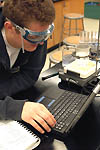 When UW-Stout's laptop program pilot began, the chemistry department volunteered to create a section of freshman chemistry for laptop students.
When UW-Stout's laptop program pilot began, the chemistry department volunteered to create a section of freshman chemistry for laptop students.
Members of the department had just witnessed innovative laboratory methods at a Wisconsin Society of Science Teachers Convention. A presenter demonstrated how to use Vernier software and tools to record and graph data during experiments. The department elected to use the same technologies in the new chemistry laptop course.
Chemistry instructors then took on the responsibility of modifying the lab manual, both to introduce new experiments and to adapt several existing experiments to include laptop use. Pre-written experiments provided by Vernier offered ideas to incorporate into the experiments they were currently requiring.
The benefits of the software and tools are important to students:
While conducting research to create a new product for infants and toddlers, UW-Stout industrial design student Matthew Wilcox decided to design an unusual chair for autistic children. His resulting design, called the "Shell Chair," earned him second prize and $1,500 in the Juvenile Products Manufacturers Association's Student Design Competition.
Although Wilcox is not personally acquainted with an autistic child, he became fascinated with improving the design of the classroom equipment currently used by four- to seven-year-old children with autism.
Wilcox's new "Shell Chair" design doubles as a toy. This, he said, allows it to be easily integrated into any classroom while lessening the stigma autistic children may face when they need to use it.
The design includes a rounded outer shell that children can remove from the compression chair, flip it over and play inside it, similar to how they would play in a fort. Because autistic children typically enjoy rocking, the outer shell is also curved to allow children to rock gently back and forth, while the chair inside the shell applies pressure to their body.
Wilcox created both a computer model and a cardboard prototype of his design, and tested the prototype with a four-year-old child. He envisions producing the chair out of the same hollow, molded, colorful plastic that many children's toys are made from.
The JPMA competition was open to industrial design students enrolled in degree programs at universities affiliated with the Industrial Designers Society of America. The judges, who are IDSA member designers, critiqued each submission based on design, research and ergonomics.
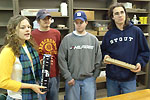 Four UW-Stout students received a bronze award from the National Paperbox Association for their golf ball package design.
Four UW-Stout students received a bronze award from the National Paperbox Association for their golf ball package design.
The graphic design students designed the package for a new premium line of Peerless 20/20 golf balls for Acculine Inc. They placed third out of approximately 50 other entries.
NPA and the Paperbox Industry Foundation host this National Student Design Competition each year. UW-Stout students have received both silver and bronze awards for their designs three out of the past four years they have entered the competition.
Acculine challenged the students to design a folding paperboard carton that would offer adequate protection to their product, reduce post-consumer waste, pack and display easily, and contain at least six balls to minimize cost.
The students received plaques and a $100 award from NPA for their accomplishment.
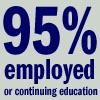 A total of 95 percent of December 2002, and January, May and August 2003 UW-Stout graduates were employed as of January 31, 2004, according to the annual employment report issued by the Career Services Office.
A total of 95 percent of December 2002, and January, May and August 2003 UW-Stout graduates were employed as of January 31, 2004, according to the annual employment report issued by the Career Services Office.
Of those employed, 76.4 percent reported employment in, or related to, their major. The median salary reported by these recent graduates was $31,000.
The Career Services Office also reported the progress of the Cooperative Education program. In all, 610 students participated in the program, with more than 400 employers providing job sites. Survey participants reported average earnings of $11.42 per hour while on co-op assignments.
(Goal 2, Figure 1)
The UW-Stout Teaching and Learning Center, devoted to the support of teaching and learning in the academic community, completed its third year of operation.
The Teaching and Learning Center facilitated a $1,000 per person Scholarship of Teaching and Learning project during 2003–04. A total of 15 applicants were funded.
The goal of the project was to provide a venue that allows teachers -- including both faculty and academic staff -- to conduct a reflective practice/scholarship of teaching investigation. Teachers were asked to identify a problem or issue in teaching and learning in one or more of their classes that they feel passionate about. The project itself was to investigate that problem or issue in such a way that a conclusion could be formed and disseminated to the UW-Stout community. Each participant joined a small group of other teachers interested in the same problem or issue. This group met several times during the course of the project.
Other developments that came from the project included:
Other activities of the Teaching and Learning Center included:
The Jeff Russell Leadership and Professional Development Certificate Program is a series of eight sessions offered to UW–Stout support staff, supervisors, managers and directors. Its purpose is to develop leadership competencies among all staff at all levels of the university. The program accomplishes this through dynamic and interactive sessions that are based on current and emerging issues. Participants in the program -- who must be nominated by a supervisor -- are expected to attend all eight courses. In all, 76 participants have gone through the program in its three years.
Sessions during the 2003–04 academic year included:
UW-Stout celebrated a 20-year connection with business and industry leaders March 24, through the Arthur A. Cabot Executive Residency program.
A generous donation from UW-Stout alumnus Scott Cabot allows the university to bring a successful business executive to campus to interact with students and instructors for one day each year.
Since the Cabot Executive Residency program began in 1984, numerous business people from such companies as McDonald's Corporation, General Motors and Mead Corporation have visited the campus to attend student presentations, speak to classes, consult with instructors, meet with student groups, and deliver keynote addresses.
Several of the executives who have visited the campus as Cabot residents in the past 20 years returned to campus to take part in the leadership panel discussion March 24.
The Cabot celebration involved as many students on campus as possible. For example, students in the graphic communications program produced the printed materials for the event. Also, students in the People Process Culture course videotaped the event and acted as personal guides to the returning Cabot residents.
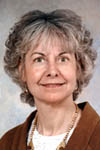 Lynnette Brouwer, associate professor in UW-Stout's hospitality and tourism department, was already intimately acquainted with the Buryat Republic before she was awarded a Fulbright appointment to teach courses there during the fall 2003 semester.
Lynnette Brouwer, associate professor in UW-Stout's hospitality and tourism department, was already intimately acquainted with the Buryat Republic before she was awarded a Fulbright appointment to teach courses there during the fall 2003 semester.
Brouwer first journeyed to Siberia in the dead of winter in 1998 to meet her new daughter at the Ieestonock orphanage. That trip spurred her interest -- both professional and personal -- in the vast region.
While in Siberia, Brouwer taught service management, leadership, tourism and English courses at East Siberian State Technological University's main campus in Ulan Ude, the capital city of the Buryat Republic, and at two other universities in the city.
Brouwer also conducted pro bono consulting for tourism organizations and helped nonprofit organizations write grants and explore their missions. She spoke to students at several high schools, helped her daughter's kindergarten classmates with their English skills, and sponsored children's and nature museum outings for the entire class, as well.
Despite the beauty and culture of the region, Brouwer admitted that living in Siberia was sometimes harsh.
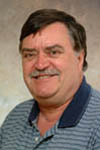 Gary S. Godfrey, associate professor in UW-Stout's technology department, spent 10 weeks at the Kennedy Space Center as a researcher for the NASA Faculty Fellowship Program.
Gary S. Godfrey, associate professor in UW-Stout's technology department, spent 10 weeks at the Kennedy Space Center as a researcher for the NASA Faculty Fellowship Program.
Chosen for his unique software expertise, Godfrey conducted numerous computer-modeling projects as part of his two-year research residency.
In a large hangar that housed collected shuttle wreckage, Godfrey worked to correct a flaw detected in the design of Columbia's door by altering its shape to better withstand high levels of force.
According to Godfrey, 3-D computer modeling helped NASA investigate the Columbia tragedy by reconstructing how the heat shield was penetrated.
Godfrey also worked on 3-D models of the assembly of an orbiter to a shuttle's external tank, the installation of an Orbital Maneuvering System Pod and the operation of landing gear. NASA will use these models to identify safety issues and train Kennedy Space Center employees. The models will also benefit engineers in their design and analysis efforts.
In addition, Godfrey prepared a depository of 3-D models by accurately translating files from several formats into a single format called Pro/Engineer Wildfire. To do this, he had to determine how to retain as many of the original model's features as possible. If he could not accurately translate a model, he redrew it from scratch.
UW-Stout student Ben Brandt joined Godfrey in the continuation of his research at the Kennedy Space Center during summer 2004.
UW-Stout's Technology Incubator continues to foster technical businesses through a close relationship with faculty, students, industry and the UW-Stout community to better enable Wisconsin to compete in the global arena and sustain employment within the region. Currently, the incubator is working with client Red Cedar Plastics, which handles production of custom specialized injection molding. Red Cedar Plastics has been working in the incubator since 2001.
Through its work while in the UW-Stout Incubator, Red Cedar Plastics offers the following services:
Along with its own equipment, Red Cedar Plastics is afforded access to the on-site laboratories offered at the incubator for development and testing purposes using state-of-the-art equipment.
Students are also benefactors of the incubator, helping the client companies with work through student projects.
Student projects done with Red Cedar Plastics include:
Governor Jim Doyle provided the headline address at "Synergy 2003: Positioning for Economic Growth," a regional conference held at UW-Stout in September 2003.
The governor spoke on strengthening economic development in the region and was joined at the conference by the secretary of the Wisconsin Department of Tourism, the secretary of the Wisconsin Department of Commerce, the secretary of the Department of Workforce Development, and the deputy secretary of the Wisconsin Department of Agriculture, Trade and Consumer Protection.
Synergy 2003 specifically addressed the critical issues that make the Chippewa Valley, St. Croix Valley and I-94 corridor the impact center for west central Wisconsin, which includes Barron, Chippewa, Clark, Dunn, Eau Claire, Pierce, Pepin, Polk and St. Croix counties.
"GLACURH 2003: Life in the Fast Lane," the annual conference for the Great Lakes Affiliate of College and University Residence Halls, was held at UW-Stout in November 2003.
Approximately 500 student leaders representing 50 colleges and universities from Michigan, Ontario, Wisconsin, Indiana and Illinois attended sessions on various leadership and educational topics that were presented by students and advisers throughout the region.
The conference was coordinated by 25 UW-Stout student leaders, with assistance from Housing and Residence Life advisers.
Affordable couple and family therapy services and various psychological evaluations for area residents were made available through the College of Human Development's Clinical Services Center at UW-Stout. The center is staffed by supervised students and faculty members of the marriage and family therapy program, and school psychology program.
The services were made available to any individual, couple or family experiencing difficulties, desiring relationship enhancement or evaluation as it relates to a particular concern, such as a child's difficulties in adjusting to school.
The psychological evaluations could also be done with children or adults.
UW-Stout has made a commitment to encourage a respectful diverse community by adopting Plan 2008, a strategic plan for diversity. Measures of progress in 2003–04 included the following:
International Week at UW-Stout was held on campus in fall 2003.
The annual event is sponsored by the International Relations Club and the Office of International Education, and is designed to emphasize global understanding through international education and exchange.
Activities during the week included a slide show from a faculty member on her trip to Namibia, Africa; a faculty panel discussion on learning more about teaching and studying abroad; and the annual international dinner, exhibits and cultural show.
The 28th annual UW System Women's Studies Conference, titled "Women's Sphere, Reconfigured Traditions," was held at UW-Stout in fall 2003.
The conference brought together academics, teachers, students and community leaders to examine how women's traditional roles in the home, the classroom, the arts and public life have been redefined.
The two-day event, which featured five speakers, concluded with the Women of Color Award Ceremony, and three art exhibits were on display during the conference. The Furlong Gallery located in the Applied Arts Building hosted an invitational exhibit of artists whose cultures included African-American, Asian, Hmong, Muslim and Native American. The works included painting, prints, sculpture, metalwork and textiles.
Over the last year, the university and the Menomonie area community continued to make significant progress to change the local alcohol and other drug abuse environment. The following are a few key activities conducted in the past year:
The Women's Faculty Mentoring Program, the Women's Academic Staff Mentoring Program, and the Classified Staff Mentoring Program continue to be successful at UW-Stout.
The Women's Academic Staff Mentoring Program offers four group events annually. "Brown Bag Lunches" are also offered twice a month, serving as an opportunity for staff and faculty to get to know one another through group lunches. The program also had an information table at the Optimal Health Fair in 2003 and 2004, and had a table at the Women's Studies conference at UW-Stout in 2003. In addition, featured events were held several times throughout the year with a total of 151 attendees across the events:
The Faculty and Academic Staff Mentoring programs received a joint Professional Development Grant in fall 2003. The grant provided funding for:
The Classified Mentoring Program also continues to help those new to the university. Mentors for the program are intended to serve as a "welcome" for new classified employees; to provide helpful information about the campus; to be a "point of contact" for questions and directions; and to foster a comfortable and secure feeling for new employees while enriching and strengthening the campus climate. Preferably, a mentor and mentee meet two to three times per month.
In addition, a new Classified Advisory Group was formed following a request from the classified staff. This group will provide more professional development opportunities for classified staff and spearhead a recognition award system for classified employees, among other things.
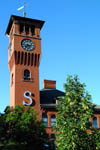 A historical landmark, the Stout "S" was restored to the campus in May 2004 after a 35-year hiatus. The original "S" was a treasured piece of Stout until 1969 when the landmark was stolen. The new "S" on the clock tower measures 10 feet high and more than six feet wide with back lighting. Fund raising is being conducted to cover the expenses.
A historical landmark, the Stout "S" was restored to the campus in May 2004 after a 35-year hiatus. The original "S" was a treasured piece of Stout until 1969 when the landmark was stolen. The new "S" on the clock tower measures 10 feet high and more than six feet wide with back lighting. Fund raising is being conducted to cover the expenses.
The "S," chosen from a 1913 annual, was made of aluminum and painted white. The Menomonie Historic Commission has endorsed its installation. While the "S" had been missing for years, its legacy was still preserved in the following phrase from the Alma Mater: "On the banks of Lake Menomin stands our Alma Mater true, with tower high and brilliant 'S,' for her we'll dare and do."
 Construction for a new residence hall on UW-Stout's north campus broke ground in spring 2004.
Construction for a new residence hall on UW-Stout's north campus broke ground in spring 2004.
The new building will be a 296-bed residence hall with 75 suites, each containing four single bedrooms, a kitchenette, living area and bathroom facilities. On each of the building's five floors will be a laundry room, recycling center, and full kitchen/lounge area. The residence hall will offer several meeting rooms, an activities room, vending areas and other amenities.
The estimated cost of the new building is $16.6 million and will be funded by user fees, not taxpayer dollars. The new residence hall will replace the aging Jeter-Tainter-Callahan Hall that will be demolished in the next few years.
Plans are for the residence hall to be completed sometime in the summer of 2005, to be ready for new residents that fall.
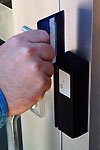 Access to all campus buildings has changed and become more restrictive than in the past, but the university and students are the benefactors of a re-keying of the campus.
Access to all campus buildings has changed and become more restrictive than in the past, but the university and students are the benefactors of a re-keying of the campus.
All residence halls were re-keyed, as well as five academic buildings and Jarvis Hall's Science Wing. The approximate target date to finish all re-keying was mid-November 2004.
Faculty, staff and students were able to pick up their new keys for the re-keyed buildings at the Key Control Center. Old exterior door keys no longer worked in the newly re-keyed facilities, and all after-hour building access was then accessible by card access only.
To increase student success, improve student retention and enhance advising effectiveness, UW-Stout's Advisement Center initiated the First-Year Advising Program. As a result, seven first-year advisers helped approximately 1,300 freshmen with their college transition.
Advisers worked with the students until spring advisement day, at which time the students transitioned to a faculty adviser in their academic program.
Goals for the program included:
The program also responded to increased instructor and program director workloads by taking some of the pressure to get new students up to speed off the shoulders of program advisers.
Twenty-five of UW-Stout's 27 undergraduate programs, and undecided students, were divided into logical groupings, giving each of the seven first-year advisers approximately 200 students. Each adviser worked closely with the directors of their assigned programs to learn program requirements and build partnerships that benefited the students.
The First-Year Advising Program was evaluated by both students and program directors through student Web-based assessments, and retention, probation and dismissal rates as compared to those in previous years. Ninety-six percent of freshmen felt very satisfied or satisfied with their first-year advising experience.
Block scheduling for freshmen was added to the original First-Year Advising Program during fall 2003. A working group that included the provost, the assistant vice chancellor, colleges and school associate deans, the registrar, and a first-year adviser was convened by the associate dean of students in November 2003 to develop and implement a plan. Although there were some problems with the first implementation, the process was deemed successful.
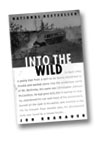 First-year students also participated in a common reading experience called "Into the Book." The program is another part of the university's continuing retention efforts, giving new students a common experience before even taking one class at UW-Stout. The coordination of the program was a joint effort between the English department and the Advisement Center.
First-year students also participated in a common reading experience called "Into the Book." The program is another part of the university's continuing retention efforts, giving new students a common experience before even taking one class at UW-Stout. The coordination of the program was a joint effort between the English department and the Advisement Center.
The goals of the summer reading program were to:
During the summer 2003, incoming freshmen read Into the Wild by Jon Krakauer in preparation for staff-student discussion groups held during fall orientation. Forty-eight staff members and 1,065 students participated in the program.
(Goal 7, Figure 1)
 The Stout University Foundation is a vigorous organization that plays a key role in positioning UW-Stout as a leader in higher education. The foundation's rapid growth directly relates to the loyal friends and alumni who recognize the importance of supporting UW-Stout and its talented faculty, staff and students.
The Stout University Foundation is a vigorous organization that plays a key role in positioning UW-Stout as a leader in higher education. The foundation's rapid growth directly relates to the loyal friends and alumni who recognize the importance of supporting UW-Stout and its talented faculty, staff and students.
The foundation has the largest endowment of the UW System comprehensive campuses, providing support for laboratory equipment, student scholarships, library resources, faculty grants and an expanded student emergency loan fund.
The foundation recognizes five endowed professorships, two endowed chairs and grants awarded to the university for diversity initiatives.
Donations to the foundation during the recent fiscal year totaled more than $1.2 million with 5,800 donors, which is positive considering the downturn in the United State's economy.
In 2003-04, the Stout University Foundation awarded $391,000 in scholarships to 420 students. These awards ranged from $500 to $6,000. The foundation also established five new endowed scholarships and 11 new annual scholarships in 2003–04.
A substantial gift received in the last fiscal year is noteworthy in that the donors wanted to spread the donation across campus to faculty, staff and students. These three new endowed awards go to recognize tenure track faculty, academic staff and students in their pursuit of fulfilling their personal and academic missions of research and continued study.
(Goal 7, Figure 2)
The Technology and Information Services Department continues to provide extensive computing, data and voice services to the campus.
During 2003–04, the department completed and continued to enhance several projects:
 A three-year accreditation was awarded to the Stout Vocational Rehabilitation Institute Services from the Commission on Accreditation of Rehabilitation Facilities in September 2003. Areas accredited by CARF include Comprehensive Vocational Evaluation Services; Community Employment Services; Job Development; Job-Site Training; Employment Assistive Technology; and Community Assistive Technology.
A three-year accreditation was awarded to the Stout Vocational Rehabilitation Institute Services from the Commission on Accreditation of Rehabilitation Facilities in September 2003. Areas accredited by CARF include Comprehensive Vocational Evaluation Services; Community Employment Services; Job Development; Job-Site Training; Employment Assistive Technology; and Community Assistive Technology.
The economic impact of UW-Stout on Dunn County and the surrounding region was the focus of a study conducted by NorthStar Economics Inc., of Madison.
The study found the university's impact to be far-reaching, providing vital growth in the economy while adding to job development in the area.
As an institution, UW-Stout contributes more than $312 million to Dunn County's economy -- and almost $344 million to the State of Wisconsin's economy -- annually. UW-Stout employees spend almost $31 million directly in Dunn County each year, while UW-Stout students spend nearly $61 million annually in Dunn County over and above their tuition, fees, and university supplied room and board. Meanwhile, visitors to UW-Stout annually spend $17 million in Dunn County.
UW-Stout's presence in the state generates more than $18 million in state income and sales tax revenue annually; approximately 47 percent of the university's $38 million state allocation for fiscal year 2002–03. More than 63 percent of the $103 million UW-Stout revenue comes from sources other than state taxes.
In addition, UW-Stout activities are responsible for nearly 6,700 jobs in Dunn County and more than 7,200 jobs statewide.
Outside the definitive revenue and jobs numbers the university supports, the study found that UW-Stout's students are making an impact locally. The university's student body contributes more than 36,000 volunteer hours and $1.7 million worth of time to local community services each year.
The study also determined that UW-Stout has an immeasurable positive cultural and social impact on Dunn County's quality of life.
The purpose of the study was to quantify the monetary contribution UW-Stout makes to the regional economy, primarily Dunn County. The monetary contribution stems from UW-Stout institutional spending as well as employee, student and visitor spending. The components of the study came together to show the total economic contribution resulting from UW-Stout's presence in the region.
The study was confined to the economic contribution of UW-Stout, which comes from institutional expenditures and payroll and student and visitor expenditures. It did not measure the economic contribution of affiliated UW-Stout organizations such as alumni associations and foundations; the economic impact of faculty and staff earnings from private consulting, book and patent royalties; the economic impact of faculty and staff expertise used by state businesses and organizations; and a host of other collateral economic activities.
With this in mind, and as impressive as the economic numbers in the study are for the university, the economic impact reported in the study understates the overall economic impact of UW-Stout.
UW-Stout was recognized with a Governor's Special Minority Business Award for making a significant percentage of its purchases from minority-owned businesses.
UW-Stout spent just less than $700,000, or 7.45 percent of its total purchases, on business with minority-owned firms in fiscal year 2003. The firms must be classified "minority" by the Wisconsin Department of Commerce.
UW-Stout has received the Governor's Special Minority Award for fiscal year 2000 (5 percent), 2001 (7.24 percent), 2002 (9.54 percent) and 2003 (7.45 percent).
Firms classified a minority business can be sole proprietorships, partnerships, corporations or joint ventures that are at least 51 percent owned, controlled and actively managed by minority group members.
UW-Stout was among 18 state government agencies honored by the governor for making at least 5 percent of their purchases from minority businesses in fiscal year 2003.
(Beyond the Challenge, Figure 1)
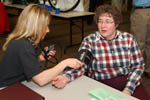 The Optimal Health Committee supports healthy lifestyles by providing UW-Stout employees with opportunities to increase their health awareness. Approximately 320 people, the largest crowd of staff and students the committee's annual Optimal Health Fair has ever seen, attended the spring 2004 fair to view health-related exhibits; eat chocolate; try out fitness equipment; and receive massages, hearing tests and blood pressure tests.
The Optimal Health Committee supports healthy lifestyles by providing UW-Stout employees with opportunities to increase their health awareness. Approximately 320 people, the largest crowd of staff and students the committee's annual Optimal Health Fair has ever seen, attended the spring 2004 fair to view health-related exhibits; eat chocolate; try out fitness equipment; and receive massages, hearing tests and blood pressure tests.
Other initiatives sponsored by the committee included:
Goal 1 | Figure 1

Source: UW System
Goal 2 | Figure 1

Source: Career Services
Goal 7 | Figure 1
| Large Group Meetings | Number Attended | Percent |
| Meet Your Adviser | 1170 | 92% |
| Into the Book Discussions | 1065 | 84% |
| Advisement Day (Fall) | 1048 | 82% |
| Transition Meeting (Spring) | 786 | 70% |
| Other Contacts | Number | Average |
| E-mails | 14,272 | 11 per student |
| Individual/Small Group Meetings | 2,755 | 2 per student |
Source: Student Services
Beyond the Challenge | Figure 1

Source: UW-Stout Purchasing Services
Published for the Chancellor's Office by the Office of University Relations
with assistance from the Office of Budget, Planning and Analysis.